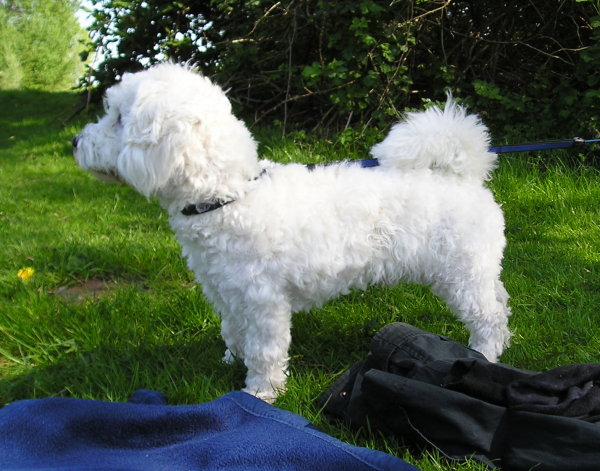- Bolonka
Infobox Dogbreed
altname =
country = Russia

image_caption = Bolonka Franzuska, one of the Bolonka breeds
akcgroup = | akcstd = | ankcgroup = | ankcstd = | ckcgroup = | ckcstd = | kcukgroup = | kcukstd = | name = | nzkcgroup = | nzkcstd = | ukcgroup = | ukcstd =Bolonka refers to small breeds of dog of the
Bichon type, originally fromRussia , developed from theBichon Frisé and further developed inGermany . They include the Franzuskaya Bolonka (Bolonka Franzuska) and the Bolonka Zwetna (bunte Schoßhündchen, Tsvetnaya Bolonka). "Franzuska" means French and "Zwetna" means multicoloured. "Bolonka" translates as "lapdog" (Schoßhündchen).Appearance
Bolonka are 24 - 26 cm high at the
withers and 2-4 or 5kg in weight. The Franzuskaya Bolonka is white, and the Bolonka Zwetna may be of various colours.Recognition
Although popular in Germany, Bolonka are not recognized as a separate breed by the
Fédération Cynologique Internationale . [ [http://rusbolonka.ru/articles_interviews/the-interview-with-petra-lindberg Interview with Petra Lindberg, includes pictures of Bolonka and discusses countries where it is recognised] ] The white version, the "Bolonka Franzuska", was recognised by the VDH (German national kennel club) as a variation of theBolognese . That Russian Bolonka are not recognised stems from the lack of a national kennel club in Russia. Without a national club, the Fédération Cynologique Internationale will not recognise the Russian dogs; in addition, there have been reports of irregularities in recordkeeping since in Russia "there is no single Kennel Club but a number of smaller clubs who basically do whatever they want." [ [http://ourworld.compuserve.com/homepages/s_tillotson/bhrussia.htm Russian Dog Scene in the 1990s] ]History
Through the connection between the Russian and French aristocracy in the eighteenth and nineteeth centuries, a type dog similar to the the Bichon Frisé of today was brought to tsarist Russia. These little white dogs were favorites of the fashionable ladies of the period in both countries. After the Russian Revolution, the breed was isolated from the French dogs. The little dogs began to be taken seriously as a native Russian breed in the 1950s, and grew in popularity. Export of the dogs was strictly regulated. In 1978 a breeding pair of Bolonka franzuska was sent as a diplomatic gift from the Soviet Union into the GDR. From these and a few others, the white Franzuskay Bolonka began to be developed as a breed in Germany in the 1980s. Eventually it was recognized by the VDF (
Verband für das Deutsche Hundewesen ) as a variation of theBolognese . At the same time a coloured version was also being developed, the Bolonka Zwetna (bunte Schoßhündchen, Tsvetnaya Bolonka, Deutscher Bolonka). These are not yet recognised although they have active breed clubs in several countries. [ [http://www.bolonka-info.de/download/Bolly-Buch.pdf Der Bolonka by Thomas Freudenthal (e-Book, in German)] ]See also
*
Bichon
*Lap dog
*Russkiy Toy Portal|Russia|Nuvola Russian flag.svgReferences
External links
Wikimedia Foundation. 2010.
